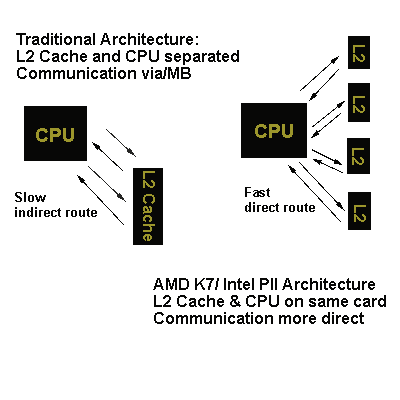One of the K7s major features is the 128K L1 cache, four times as much as the Pentium II has, and twice as much L1 as AMDs K6(-2). What's the big deal about having a lot of L1 cache anyway? The L1 cache holds the most commonly used data in the running application. L1 cache is the first place the CPU looks for information. More L1 cache means that more information can be stored "closer" to the CPU, which in turn, translates to reduced latencies between data retrieval, which means faster performance. Furthermore, many business applications constantly manipulate the same data. These applications can benefit greatly from an increased L1 cache size because there is a better chance that the CPU will have the application data in the L1, increasing performance. The operations performed by most business applications are so trivial that I/O, both internal and external (Hard Drive, for example) is a significant limiting factor in performance.
What kind off performance increases should we see with 128K L1 cache? It's difficult to tell exactly, and even after the K7 is released it will be difficult to isolate the L1 cache and analyze the performance increase. The next page will discuss probable performance increases due to doubling the L1 cache size.
L2 cache
The AMD K7 will feature an "on card" L2 cache as found in the Pentium II. Yes, that means the K7 will be inside a cartridge, like the PII. The speed of the L2 cache is configurable-- it can range anywhere between 1/3 clock speed all the way to full speed. The size of the L2 cache is currently limited to 512KB; however, AMD will release revisions of the K7 capable of addressing up to 8 MEGABYTES of L2 cache.

We all know from the Pentium II that on-card cache running at even half clock speed is much faster than slow cache on motherboards running at bus speed. Increasing cache speed is an easy way to get a significant performance increase. For AMD, it is an easy upgrade well worth it.










0 Comments
View All Comments